Meletis
| Meletis | |
|---|---|
| Information | |
| Plane | Theros |
| Colors |
|
| Demonym | Meletian[1] |
| Part of | Mortal Realm |
| Scryfall Statistics | |
|
37 artworks | |

Meletis (/mɛlitɪs/, Mehl-EE-tis[2]) inspired by Athens,[3] is the largest polis on Theros. It is a city-state of progressive thinkers, pious thaumaturges, and wise oracles on the Coast of the Siren Sea. Meletis was born from the defeat of tyranny, and to this day, it retains a spirit of the triumph of free thought over brutish force. Meletians pride themselves on their great temples to the gods, their thaumaturgical academy, their great works of architecture, and their Reverent Army. Meletis is associated with white and blue mana.[4] The Twelve, a council of philosophers headed by Perisophia, serves as the ruling body of Meletis.
History
| “ | Evil flourishes where ignorance thrives. | ” |
—Perisophia the philosopher | ||
Birth of the poleis
In the age of antiquity, the humans of the region that would one day become Meletis, the largest polis on Theros, were ruled by the archon tyrant Agnomakhos.[5] Agnomakhos ruled with an iron fist for centuries, apparently immortal, outliving the generations of leonin that he used as his soldiers and personal guard.[6] Agnomakhos aggressively expanded his empire during his reign, spreading it as far as the forests to the north and the mountains to the east, imposing merciless order over the wilds wherever he went.
While numerous rebellions attempted to cast off the archon's rule, each was crushed by his armies of giants, leonin, and other fearsome creatures. When the heroes Kynaios and Tiro sought to inspire an uprising, few flocked to their banner. According to legend, the god Ephara offered to aid Kynaios and Tiro in their battle against the tyrant, supplementing their martial skill with a new weapon: magic.[6] With their new power, Kynaios and Tiro overthrew Agnomakhos, cast out the leonin, and freed Meletis from tyranny.[5]

The polis of Meletis was founded on the ruins of Agnomakhos's empire as a beacon of freedom and enlightenment. Ephara established the polis's legal code and defended it for decades. Its people chose Kynaios and Tiro to be its guardians.[7] For a time, Kynaios and Tiro ruled Meletis, striving to govern by the highest philosophical and ethical principles, which ultimately led them to relinquish their power and establish a philosopher-led republic.[6] Two great statues were built in their honor, and stand to this day - the Guardians of Meletis. The council of scholars known as the Twelve took up the rule of the polis, with the sage Elpidios serving as the senior member. Agnomakhos's fall remains a point of honor in the minds of Meletis's people, a moment immortalized in relief upon countless civic buildings throughout the polis. To this day, the leonin remain detached from Meletis and uninterested in trade or dialogue.
The rise and fall of Xenagos
When the satyr planeswalker Xenagos returned to his birthplane, he found his old hedonistic lifestyle exceedingly dull and the gods to be a farce in which he was no longer willing to participate.[8] His ambitions had evolved into a desire for outright godhood, to join or replace the pantheon of Theros, and so in 4559 AR he began gathering his forces of eldritch, otherworldly monsters to attack the poleis of Meletis, Akros, and Setessa. These attacks became so severe that the gods themselves went blind, cut off from their oracles during the Silence of the Gods. This drove the gods into a panic, which escalated as they blamed the others of their kind for the transgression. Only Nylea seemed to be aware of the threat he posed, but with his otherworldly magic, none of the gods could truly stop him.
In circumstances largely under mystery, Xenagos managed to ascend to godhood. This occurred during a minotaur siege at Akros, battled off by armies led by Elspeth. The victory celebration was the final ingredient to Xenagos' divine ascension, and in the ensuing turmoil, the Sun god's champion was ironically scapegoated for this, resulting in her exile to the wilderness. Xenagos now held the position of the God of the revels, furthering the chaos and distrust of the established pantheon.[9] Heliod was particularly offended by his ascension and sought to destroy the satyr, whom he referred to as "the usurper". He planned to punish all mortals for the actions of the new god.
Beyond Death
Roughly one year later, the god Heliod contemplated the fragility of his immortality. He would not allow anyone to take his place in the pantheon—not even the other existing gods. To that end, he pulled the soul of the oracle Daxos and transformed him into his champion in the mortal realm. Now a demigod, Daxos was instructed to remove all traces of the other gods from the great city of Meletis. The other gods, refusing to stand for such an affront, called upon their champions from the Underworld; with this, the gods were at war.
Phyrexian invasion
In 4562 AR, led by a Phyrexian Ajani Goldmane, the first wave of the New Phyrexian Invasion targeted temples and other places of worship.[10] Due to the nature of faith on Theros, compleating the gods' devotees meant that the gods themselves, influenced by their new Phyrexian worshippers, succumbed and became Phyrexians as well. In the course of the invasion, most of the gods were compleated.[11] Meletis stood as the last bastion of resistance against an endless onslaught of Phyrexian armies.[10] Hordes of Phyrexian monstrosities assailed the city from air, land, and sea, while Meletian defenders fought valiantly to drive them off. With the aid of Ephara, one of the few surviving Theros gods, sustained by the belief of those within the city walls, they managed to hold their own. Outside of Meletis, the omenpaths of Realmbreaker reached into the underworld, where they were met with Kroxa, whose voiding maw completely obliterated the invaders.
Geography
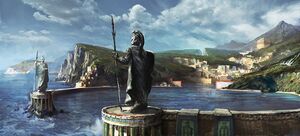
Meletis lies along the coast of the Siren Sea, encircled by rivers and broad, terraced grasslands.[6][5] Fields of cultivated sitra barley feed both the Meletian people and their livestock. Though well-worn roads crisscross the countryside, most locals prefer to travel by boat along the coast and rivers.[6] A massive sea wall shields the polis's port on the Bay of Meletis, while a long channel cuts through the hinterlands to connect the city to Meletis Harbor and the open Siren Sea.
The architecture and scholarly institutions of Meletis stand as monuments to the triumphs of human civilization. Its streets are paved with interlocking bricks, each one designed to illustrate concepts from both mathematics and magic. Towering temples line the avenues—some dedicated to individual deities, others serving as neighborhood shrines to the pantheon at large, demonstrating the Meletians' deep reverence for the gods.[6]
Within the city, threats from the wilderness seem distant. Dangers from the sea are more immediate, but again, the great sea wall and engineered waterways offer strong defenses. Though Meletis itself represents the cultural and intellectual heart of Meletian identity, the polis encompasses far more than just the city. Its lands stretch across numerous outlying settlements and pockets of wilderness, whose residents are no less Meletian. These rural folk share the values of their city-dwelling kin, even if their lives grant fewer opportunities for formal study in magic or philosophy.[6]
Branches of the river Kheir (meaning "Hand" in Ancient Greek) fan out across the region, carrying fresh water and trade goods between the city and its distant villages.[5]
Locations in the polis of Meletis
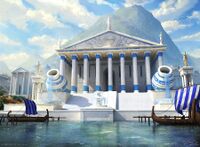
- The Dekatia Academy - the legendary academy at Meletis, is the most elite academy for philosophers and mages on Theros.[12] After receiving basic education elsewhere, the most promising thinkers and mages spend up to ten years training at the Dekatia, apprenticing to master priests, thaumaturges, philosophers, and military heroes.[6] Those who manage to complete this decade of training are renowned as the wisest of the wise and the bravest of the brave, combining all the essential learning of the polis into one heroic package.
- The Healing Ward - a place where healers work to attend to those who suffer injuries or ailments.[13]
- The Hinter Gate - the city gate that leads the grain fields outside the city and on to the Four Winds Plateau.[14][15]
- Kheir River
- runs from beneath the Four Winds Plateau and winds through the heart of Meletis, emptying into Meletis Bay.
- Meletis Harbor along the river.[5]
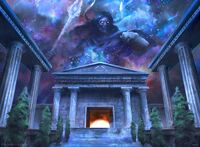
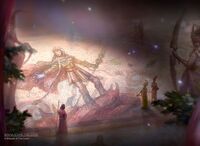
- The Observatory - a tall viewing platform and a windowed structure offering a splendid view of the sky, renowned as a place to study Nyx, the home of the gods. Special crystals shaped by thaumaturges and blessed by the oracles of the gods enhance the view, making it easier for observers to see the workings of the gods among the stars and constellations. Priests, mages, and philosophers interpret what they see in the Observatory as signs and omens from the gods.[6]
- The Pyrgnos - a lighthouse and repository of scholarly knowledge housed in a glowing stone tower standing near the coast. Functioning like a lighthouse at night, it is formed from the collected learnings of the polis, recorded on carved stone tablets and glowing letters hovering in the air. The light casts out across where the sea wall meets the shore, gleaming on the waters of the Siren Sea. Partially destroyed by the kraken Tromokratis around 4550 AR, it has since been repaired and continues to grow.[6]
- The Temple of Enlightenment
- the temple devoted to Ephara, patron of the polis.[13]
- Hall of Heliod's Generosity
- a vast temple complex devoted to Heliod, larger even than the Temple of Enlightenment.[13]
Locations in the surroundings of Meletis
- The Four Winds Plateau – A vast, bone-white tableland located just inland from the mouth of Meletis Harbor. This barren plateau, adjacent to the city, is considered a sacred site.[17][14][6] It has witnessed numerous battles and tragedies throughout history, including the fall of the Archons of Trax, the murder of the first Nyxborn Nykthos, and Elspeth Tirel’s fabled clash with Polukranos the World Eater. In recognition of its storied past, the gods declared the land "temenos"—hallowed—and forbade any construction upon it, decreeing that "only the four winds were allowed to call it home."[17]
- Guardian Way - a road leading from Meletis, past the grain fields and through the Four Winds Plateau to the edge of the Nessian Forest. The name-giving guardian statues are visible from the path.[14][15]
- Guardians of Meletis
- two giant statues representing Kynaios and Tiro, standing at the foot of the Foor Winds Plateau and guarding the inlet leading from the sea to Meletis.[16]
- Meletian Holdings - numerous settlements on the polis's lands:[6]
- Altrisos. A Kraken that escaped its sealock once threatened the small seaside city of Altrisos.[6] Recently weakened by a triton raid, the city had no defenses left and would be destroyed by an attack. The people prayed to Ephara, and the large image of her face on the city's wall came to life. The walls of the city grew impossibly high and strong, and the Kraken could do no more than dash its head against the impassable barrier. The monster soon returned to the ocean to find an easier meal. Altrisos now has Ephara's face on nearly every building and wall in the entire city in gratitude.
- Glossion - a small coastal which boasts a remarkable library that according to local legend was a gift from Ephara.[6] Other tales suggest that the library was founded by an ancient sage named Anatheia, but then a terrible fire destroyed the place, and along with it generations of collected knowledge. Once the people finished rebuilding the structure to start the library over, Ephara is said to have appeared and restored the books and scrolls the library had lost, copying the information from her scrolls of sacred knowledge. The bulk of the town's economy revolves around maintaining the library and meeting the needs of travelers who come to visit it.
- Krimnos - home of the famed philosopher Anapse.[6] The village of Krimnos attracts many philosophers who share Anapse's delight in the pleasures of a simple life.
- Listes - a fortress marking the northeastern border of the polis.[6] The civilian population is hardly less disciplined than the members of the Reverent Army stationed there, and the whole population observes Iroas's holy days together.
- Natumbria - whose residents are famous for training sea animals as skillfully as Setessans train land and air animals.[6] They train sea snakes, dolphins, and even sharks on a few occasions to be combatants, working animals, aquatic mounts, and companions.
- Neolantin - though its people are regarded as Meletians, they view themselves as citizens of Olantin, a coastal polis that long ago vanished into the sea.[6] According to legend, an angry Heliod smote the polis with his spear, sinking it in punishment for its people's utter hubris. The fact that the Neolantians were spared this fate, they say, is evidence of their humility, and they take special care in their sacrifices to Heliod.
- Oxus is a quiet town with a notably wealthy population, consisting largely of merchants who have retired from trade with large fortunes at their disposal.[6] The tomb of Kynaios and Tiro stands in the center of the town, the subject of many local legends.
- Phaela - a small fishing village, most noted as being the literal "end of the road" for travelers venturing south from Meletis. The rugged lands beyond are rocky and scattered with forgotten ruins.[6]
- Sitrium - a coastal town known for the way many of its buildings are on stilts to accommodate the changing tides.[6] Sitrium is famed for its skilled shipwrights.
- Thesteia - a village little more than a crossroads, but it's notable for its temple to Karametra.[6] The site draws farmers from the region who offer a portion of their crops to the god of agriculture.
- Meletis Bay
- serves as easy access into and out of Meletis by sea. The polis is protected by a large sea wall overlooked by the two stone statues of Kynaios and Tiro.[6]
- The Meletis River
- a tidal estuary connecting Meletis Bay to the Sea of Sirens via a passage past the Guardians of Meletis.[16]
Lagonna Grounds
Along the northern border of Meletian lands, between the Siren Sea and the Nessian Wood, dwell the centaurs of the Lagonna Band. In contrast to the warlike Pheres, the Lagonna are largely peaceful and refrain from raiding Meletian territory. They are frequent and welcome visitors in Listes, Krimnos, and even Meletis itself, often serving as traders between Meletis and Setessa thanks to their ease of travel through the Nessian Wood — a region that proves difficult for most Meletian merchants to navigate.[6]
Culture
Religion
Meletians are very concerned with the actions of the gods.[5] Even the streets of Meletis are formed of bricks of interlocking geometric shapes, demonstrating mathematical and mystical principles.[5] The wildlands of Theros feel distant, almost mythical, from inside the city's bounds. Meletis does suffer attacks from sirens, tritons, and larger monsters, but many citizens of Meletis have never seen in person any monster bigger or more exotic than a centaur.
Almost every street of Meletis bears a temple, from simple, one-room neighborhood shrines to six-story temples held up by phalanxes of marble columns.[5] Every god has a temple in Meletis, and many temples are devoted to multiple gods. Artisans continually improve the temples in Meletis, swapping out broken marble or crumbling sculptures with fresh materials and painting over grand friezes with even grander ones.
The temple of Ephara in Meletis is the god's largest and grandest place of worship on Theros.[6] It is kept in perfect repair, and worn or damaged pieces of the structure are quickly replaced. During an enormous earthquake, many of the structures in Meletis crumbled. Ephara kept her temple standing throughout the mighty quake, making it a place for Meletians to take refuge in the following days during the aftershocks. After the cataclysm, she shared designs from her scrolls of sacred knowledge with the architects of Meletis so they could rebuild the city to be much more resistant to earthquakes.
Many families in Meletis followed a practice of bowing or winking in the direction of dawn's first light, in a gesture of respect for the sun god's luminous "eye."[6] More dedicated worshipers offer short litanies at dawn, noon, and dusk, acknowledging the sun's passage across the sky.
Calendar
Although the method of marking years on Theros is unknown, Meletis has developed a calendar that has been at least partially adopted in the poleis of Akros and Setessa. The calendar is composed of 12 months, each beginning with the new moon, alternating between 30 and 29 days, and named after a festival celebrated during that month. Roughly every three years, an extra 30-day month is added to the end of the year, giving Theros a 364-day year, meaning its years are likely the same length as on Earth.[6]
- Lyokymion
- Protokynion
- Astrapion
- Polidrysion
- Thriambion
- Megasphagion
- Chalcanapsion
- Necrologion
- Therimakarion
- Katabasion
- Cheimazion
- Agrypnion
- Anagrypnion (occurs every three years)
Inhabitants
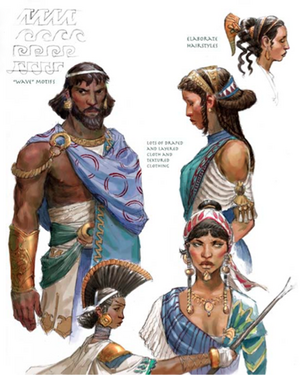
The people of Meletis take pride in their city's grand architecture, especially the great temples of the gods.[6] They value philosophy and other intellectual pursuits, especially the practice of magic. Meletis's army is known for its discipline and piety, and its navy is unparalleled. The city observes every one of the gods' holy days in various ways, and most residents try to live as the gods demand. Rich fields and the bounty of the sea support most people throughout Meletis. The people have reputations for being accomplished weavers, skilled sailors, and cunning merchants. Books and literacy are also common throughout the land, and the work of scribes, cartographers, musicians, and storytellers is well regarded. The people of Meletis believe themselves to be the inheritors of a heroic tradition, and each person owes it to themselves and to society to strive for greatness. Beyond Meletis's common folk, a few groups that hold noteworthy standing are detailed here.
Citizenship is limited to those whose parents were both citizens of the polis.[6] Citizens of other poleis, and their children, aren't permitted to participate in the government of the polis.
Weaving magic is a time-honored tradition in Meletis; magic is seen as one of the greatest arts an artisan can master.[5] The most accomplished mages are known as thaumaturges ("wonder workers"). Many Meletian mages are trained at the elite academy of the Dekatia, but countless smaller schools and private tutors teach the magical arts.[6] These lessons in magic typically include a well-rounded education in the sciences and philosophy. Some thaumaturges find their magical studies aligning with popular Meletian philosophies and choose the schools of magic they focus on based on such teachings. The mark of a true thaumaturge, though, is a gift or positive omen from the gods; even the most accomplished student of magic can't earn the title without such a sign of divine approval.
Prized among Meletis's thaumaturges, anvilwrought raptors are often crafted in the form of a hawk or an owl.[6] Most serve as messengers and spies, flying over the busy streets or high over the land while carrying or seeking vital information for their masters.
Meletis is a polis of industry and building.[5] Stonewise thaumaturges specialize in magic that erects and restores buildings and other such edifices. Stonewise mages are crucial to the Reverent Army when creating inland military outposts.
Aether is of particular interest to Meletian scholars, and many study its use in magic[5]. Some believe that aether is the realm of abstract entities, such as numbers, concepts, and theories. Some formalists study magics that allow them to cause objects to disappear from physical reality. They say they are "perfecting" real, necessarily flawed, concrete objects by transferring them to the realm of perfect, abstract entities.
Non-Humans
Meletis strives to be a beacon to all of Theros's people.[6] Well-intentioned members of any culture are welcome on Meletis's streets, and the polis's people work to earn the trust of their neighbors.
Among the poleis of Theros, Meletis maintains the strongest ties with the tritons who dwell in the Siren Sea. Tritons, though limited in how long they can remain out of the water, still have a presence in the coastal city of Meletis.[5] Some take on roles as watchkeepers and guardians of the coastline, standing vigil in towers to alert the city of threats from krakens, archons, or other sea-born dangers. Others are found tending the city baths or sharing their insights as visiting philosophers at the Dekatia.
Tritons frequently handle tasks that require working in or beneath the waves, doing jobs that land-dwellers cannot easily manage. However, tritons in Meletis are increasingly moving beyond maritime duties alone. It is now common to see tritons running eateries, practicing alchemy, or even serving as soldiers within the Reverent Army.[6]
Many Pheres Band centaurs are hostile to Meletians, but Meletis officially maintains a fragile peace with the Lagonna Band.[5] Some smaller centaur tribes have established a profitable trade with the polis. It's not uncommon for small groups of centaurs to set up shop in the polis market for short periods, though few spend more than a night or two in the city, most finding it claustrophobic at best.[6] Meletian officials even designate two holidays during the year, making allowances for the overlap with certain centaur celebrations.[5] By the peace, Meletian outposts generally allow smaller centaur bands to move across their surveyed lands, but some Meletian soldiers aren't happy about it.
Few leonin journey to Meletis; most view it as a cursed place.[6] Those few who have traveled to the polis in recent years find it changed, with great potential for trade and cooperation, but no Meletian or leonin has yet initiated an official dialogue between the two peoples. Most satyrs have little patience for Meletian philosophy, visiting largely out of curiosity or on elaborate larks. Minotaurs are rarely seen in Meletis, though those who visit with peaceful intentions are welcome.
The wise and ancient sphinx Medomai is not a consistent resident of Meletis, though he appears a few times a year during moments of historical import, such as religious ceremonies, coronations, and the onset of wars.[5] Medomai has been part of Meletis's history for many decades, seeming to possess cryptic knowledge of future events, but since his predictions tend to be dire, his arrival is generally viewed as a bad omen.[6]
Military
Meletis is defended by the Reverent Army, religiously trained soldiers who fight monsters and exalt the gods.[5] The Meletian Reverents are not as fierce as Akroans nor as sturdy as Setessans, but they are clever and resourceful, and they believe their superior piety for Theros's pantheon leads them to more success in battle. Bolstered by trained griffin and pegasus steeds, they strike foes where they least expect.[6]
Meletian soldiers are trained to manipulate the battlefield primarily through tactics rather than through physical strength.[5] Their hoplites, known as the Battlewise use clever ruses, unusual or rapidly changing troop formations, and even outright deception to score victories. It's said that every Meletian soldier knows at least one spell. That may be an exaggeration that Meletians allow to circulate, but many Meletian hoplites could indeed be considered low-level taskmages. Spells of healing, endurance augmentation, and battlefield trickery are often taught during soldier training.
Meletian hoplite units include:[6]
- Kraken's Claw
- Hands of justice
- Thassa's Spear
- Ephara's Shield
- Kindred of the Deep
- Riders of Heliod
- Keepers of Pyrgnos
- The Skysworn
Philosophy
Meletis is world-renowned as the center of philosophical thought.[5] Many Meletians speak of the "edifice of knowledge," referring in the abstract to the sum of all learning and scholarship.[6] Every citizen is expected to help improve this edifice for the good of the polis, whether through philosophical exploration, advancements in magical technique, the investigation into the nature of the gods, or perfection of techniques in crafting and trade.
Though they aren't necessarily heroic, philosophers are highly valued in Meletis. They form a privileged class, often coming from wealthy families but also supported by stipends from the polis's academies and their students. They are often attended by servants so that they might spend more of their time debating, thinking, and teaching.[5] Different philosophical schools hold political as well as intellectual power in the polis, with five schools of philosophy dominating Meletian discourse.[6]
Perisophia's optimistic Elpidian school currently predominates Meletian thought and politics, carrying on the works of the heroic Epharan oracle Elpidios.[6] The Elpidian school strives to put magic and philosophy to use in improving the lives of all Meletians. Elpidian mages embrace the magic in all its forms.
Formalist philosophers believe in a realm populated by abstract entities such as numbers and theories.[6] They focus their efforts on trying to improve the moral fabric of the polis, hoping to create the ideal society, where people live together in peace, and where war and crime disappear. This school is based on Platonism.
The Uremidean school emphasizes logical reasoning, rhetorical excellence, and theories of ethics and virtue.[6] Uremideans are eminently practical governors who seek to balance ethical ideals and realistic necessities. This school is named after the philosopher Uremides and is based on Aristotelianism.
Nyklean philosophers teach that reason or destiny underlies all of reality so that everything that takes place must unfold just as it does.[6] These philosophers train themselves to accept and endure whatever befalls them, enjoying good fortune but not grieving its loss. This school is named after the philosopher Nyklos and is based on Stoicism.
Anapsian philosophy embraces the fine delights of life: the pleasures of love and friendship, fine food and drink, art and music.[6] Anapsians have few strong opinions about governance, except that an ultimate good end should be kept front of mind in all decisions. This school is named after the philosopher Anapse and is based on Epicureanism.
Government
Ephara is credited with establishing the first code of law, which Meletis has preserved, and the other poleis have imitated.[6] She is most beloved in Meletis, whose citizens credit her with the city's founding. Kynaios and Tiro, the original rulers of Meletis, relinquished their power to establish a philosopher-led republic.[6]
A council of philosophers called the Twelve now serves as the ruling body of Meletis.[6] They are elected by popular vote among the citizens of Meletis and serve for terms of four years at a time. They are supposed to be governed by philosophical principles of justice and social order, and many of them strive to uphold the highest ideals in their decisions. Others are more grimly realistic, and a few are deeply corrupt, serving only their interests. The most senior member of the council is recognized as its leader, responsible for bringing the assembly to order and moderating its debate.
Known current or former members of The Twelve include:
- Perisophia, the current leader of the Twelve.
- Elpidios, the original leader of the Twelve.
- Olexa, a member of the Twelve in 4559 AR
Economy
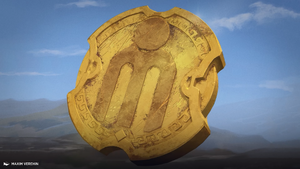
Trade between Meletis and Akros is constant and productive.[6] Caravans make the two-day journey between the poleis at least once a week, carrying fine Akroan metalwork and pottery to Meletis, and Meletian fabric, stonework, and fish northward. Both poleis mint coins of copper, silver, and gold, with the equivalent value. Setessa trades with the other poleis as well, but less extensively. The Abora Market, just inside the city gates, is open to outsiders only on certain days, and Setessan merchants prefer to barter goods rather than accept the currency. Despite these restrictions, Setessan food, woodwork, and trained falcons are highly valued in the other poleis.
Aside from the other human poleis, Meletis and Setessa both trade with the centaurs of the Lagonna band.[6] The centaurs don't work metal, so they trade woodwork, the produce of the plains, and woven blankets to the human poleis in exchange for weapons and armor.
Notable Meletians
- Callaphe, the plane's greatest mariner and a legendary trickster. Later chosen by Thassa as her demigod and champion.
- Daxos, renowned oracle able to hear all of Theros's gods. Later chosen by Heliod as his demigod and champion.
- Elpidios, oracle of Ephara and first leader of the Twelve after Kynaios and Tiro's death.
- Kydele, oracle of Kruphix at his temple in the city.
- Kynaios and Tiro, the polis's founders.
- Niko Aris, gifted athlete and Planeswalker.
- Perisophia, most influential of the Twelve that rule Meletis.
- Psemilla, a poet and bard with a connection to the Nymphs.
- Thrasios, a Triton hero who lives among the humans of Meletis.
- Tymna, a former Battlewise soldier and current weaver.
Trivia
- The polis may take its name from the Anatolian city of Miletus, a center of art, science, and philosophy.
- The Pyrgnos may be inspired by the Pharos lighthouse in Alexandria and possibly the Pnyx in Athens.
- The village of Thesteia may be inspired by Eleusis, the site of the Eleusinian Mysteries and the center of worship for Demeter in Attica.
- The town of Glossion may be inspired by the Library of Alexandria, and its name is possibly taken from the Ancient Greek word glôssă (meaning "tongue" or "language"; the root of the English word glossary).
Gallery
-
Concept art by Adam Paquette.
-
Concept art by Adam Paquette.
In-game references
- Associated cards:
- Depicted in:
- Referred to:
- Alseid of Life's Bounty
- Anvilwrought Raptor
- Archetype of Imagination
- Boulderfall
- Celestial Unicorn (Foundations Jumpstart)
- Chosen by Heliod
- Deepwater Hypnotist
- Dryad of the Ilysian Grove
- Elite Instructor
- Epiphany Storm
- Fleetfeather Sandals
- Floodtide Serpent
- Flummoxed Cyclops
- Glimpse of Freedom
- Hold at Bay
- Lampad of Death's Vigil
- Leonin Snarecaster
- Loathsome Chimera
- Naiad of Hidden Coves
- Nessian Hornbeetle
- Nyxborn Shieldmate
- Oread of Mountain's Blaze
- Pull from the Deep
- Sinister Starfish
- Surge of Salvation
- Thaumaturge's Familiar
- Thundering Chariot
- Vexing Gull
References
- ↑ Flavor text of Boulderfall (Theros).
- ↑ Wizards of the Coast (September 26, 2013). "Theran Pronunciation Quiz". magicthegathering.com. Wizards of the Coast. Archived from the original on 2021-04-30.
- ↑ Mark Rosewater (7 August 2015). "Here is the inspirations for the three main cities (aka poleis).". Blogatog. Tumblr.
- ↑ Doug Beyer (August 28, 2013). "Are Akros, Setessa and Meletis all associated with specific colours?". A Voice for Vorthos. Tumblr.
- ↑ a b c d e f g h i j k l m n o p q r s The Magic Creative Team (August 28, 2013). "Planeswalker's Guide to Theros, Part 2". magicthegathering.com. Wizards of the Coast.
- ↑ a b c d e f g h i j k l m n o p q r s t u v w x y z aa ab ac ad ae af ag ah ai aj ak al am an ao ap aq ar as at au av aw ax Wizards RPG Team (2020), D&D Mythic Odysseys of Theros, Wizards of the Coast
- ↑ Magic Creative Team (October 26, 2016). "It's Time to Talk Commander (2016 Edition)". magicthegathering.com. Wizards of the Coast.
- ↑ Xenagos. Planeswalker Biography. Wizards of the Coast. Retrieved on October 02, 2013.
- ↑ The Magic Creative Team (January 08, 2014). "Planeswalker's Guide to Born of the Gods". magicthegathering.com. Wizards of the Coast.
- ↑ a b Emily Teng (April 11, 2023). "Planeswalker's Guide to March of the Machine: The Phyrexian Invasion of the Multiverse". magicthegathering.com. Wizards of the Coast.
- ↑ Mark Rosewater (April 10, 2023). "Choosing Your Battles, Part 1". magicthegathering.com. Wizards of the Coast.
- ↑ Mike McArtor (February 20, 2014). "That's the Spirits!". magicthegathering.com. Wizards of the Coast. Archived from the original on 2021-04-29.
- ↑ a b c d e Jenna Helland (May 2014) - Journey into Nyx: Godsend, Part II, Wizards of the Coast. ISBN: 978-0-7869-6567-0.
- ↑ a b c Seanan McGuire (October 26, 2022). "The Brother's War - Chapter 4: The Dark". Magicthegathering.com.
- ↑ a b Jenna Helland (2014) - Theros: Godsend, Part I, WotC, Prologue.
- ↑ a b c Jenna Helland (2014) - Theros: Godsend, Part I, WotC.
- ↑ a b Theros: Godsend, Part I, Chapter 10


